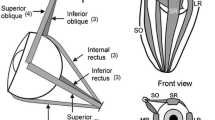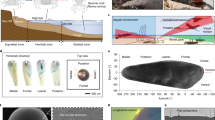Abstract
CHAMELEONS are arboral lizards that spot their prey visually and catch it by highly precise shots with their long sticky tongue. They scan their environment by large-amplitude independent saccadic eye movements; once an insect is detected, the head axis is aligned towards the target ('head tracking'1, both eyes come forward to fixate the insect and, in a phase called 'initial protrusion'2, the sticky tongue is loaded with tension by a special hyoid apparatus3 and subsequently shot out of the mouth with great precision. Lenses placed in front of the eyes produce predictable errors in distance estimation4, suggesting that chameleons rely on accommodation cues when measuring the distance to their prey, but focusing has never been measured directly. Using a new technique to measure accommodation5, we now show that accommodation is precise enough to serve as the major distance cue. Because accurate focusing requires large retinal images, we have tested image magnification and find that it is higher than in any other vertebrate eye scaled to the same size. This is a result of a unique optical design: unlike other vertebrate eyes, the crystalline lens of the chameleon has negative refractive power. Although there is a trend among vertebrates to increase corneal power and to decrease lens power with higher visual acuity, only in the chameleon eye has this tendency led to a reversal of the sign of the power of the lens.
Similar content being viewed by others
References
Flanders, M. Vision Res. 25, 935–942 (1985).
Altevogt, R. & Altevogt, R. Z. Vergl. Physiol. 36, 66–77 (1954).
Wainwright, P. C. & Bennett, A. F. J. exp. Biol. 168, 1–21 (1992).
Harkness, L. Nature 267, 346–349 (1977).
Schaeffel, F., Hagel, G., Eikermann, J. & Collett, T. J. Opt. Soc. Am. A11, 487–495 (1994).
Wagner, H. & Schaeffel, F. J. comp. Physiol. A169, 515–521 (1992).
Miller, W. H. in Handbook of Sensory Physiology Vol. VII/6A (ed. Autrum, H.) 69–143 (Springer, Berlin, 1979).
Martin, G. in Perception and Motor Control in Birds (eds Davies M. N. O. & Green, P.) 5–30 (Springer, Berlin, 1994).
Schaeffel, F. & Howland, H. C. J. comp. Physiol. A160, 375–384 (1987).
Schaeffel, F. & Howland, H. C. Clin. vis. Sci. 3, 83–99 (1988).
Young, T. Phil. Trans. R. Soc. 19, 23–88 (1801).
Glickstein, M. & Millodot, M. Science 192, 605–606 (1970).
Citron, M. C. & Pinto, L. H. Vision Res. 13, 873–876 (1973).
Schaeffel, F., Glasser, A. & Howland, H. C. Vision Res. 28, 639–657 (1988).
Hughes, A. in Handbook of Sensory Physiology Vol. VII/5 (ed. Crescitelli, F.) 613–756 (Springer, Berlin, 1977).
O'Keefe, L. P. & Coile, D. C. Ophthal. Physiol. Opt. 8, 97–100 (1988).
Author information
Authors and Affiliations
Rights and permissions
About this article
Cite this article
Ott, M., Schaeffel, F. A negatively powered lens in the chameleon. Nature 373, 692–694 (1995). https://doi.org/10.1038/373692a0
Received:
Accepted:
Issue Date:
DOI: https://doi.org/10.1038/373692a0
- Springer Nature Limited
This article is cited by
-
Widespread bone-based fluorescence in chameleons
Scientific Reports (2018)
-
Vergleichende Betrachtung von Lichtempfindlichkeit, Tiefenwahrnehmung und Bewegungswahrnehmung bei Tier und Mensch
Der Ophthalmologe (2017)
-
Avoidance of a moving threat in the common chameleon (Chamaeleo chamaeleon): rapid tracking by body motion and eye use
Journal of Comparative Physiology A (2016)
-
Eye movements of vertebrates and their relation to eye form and function
Journal of Comparative Physiology A (2015)
-
Defeated chameleons darken dynamically during dyadic disputes to decrease danger from dominants
Behavioral Ecology and Sociobiology (2014)





